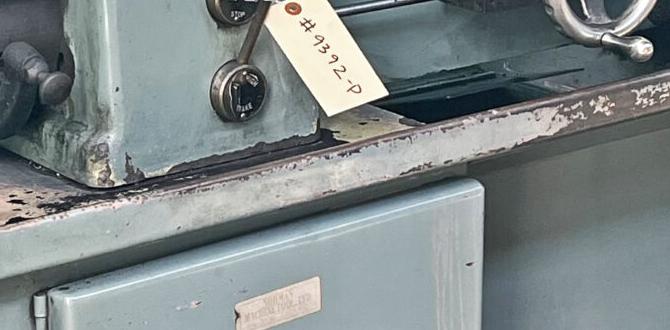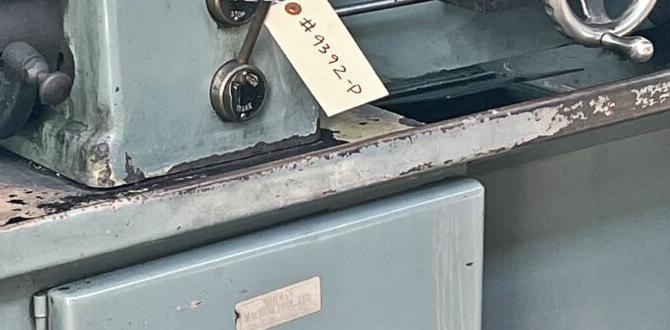Quick Summary: To achieve chatter-free brass milling, use a single-flute carbide end mill with a polished flute and a specific cutting edge geometry designed for soft metals. Key factors include appropriate feed rates, spindle speeds, and secure workpiece clamping.
Proven Carbide End Mill For Brass: Chatter-Free!
Ever tried to mill brass and ended up with a noisy, vibrating mess? You’re not alone! Chatter is a common frustration for anyone working with metal lathes and milling machines, especially when cutting softer materials like brass. It leaves rough surfaces, can damage your workpiece, and makes your machine sound like it’s about to fall apart. But don’t worry, getting smooth, chatter-free cuts in brass is absolutely achievable. With the right end mill and a few simple techniques, you’ll be finishing your brass projects beautifully. Let’s dive into finding that perfect tool and making brass behave!
Why Brass Chatter is a Common Problem
Brass is a fascinating alloy, known for its machinability and attractive finish. However, its softness and tendency to “gum up” cutting tools can lead to chatter if not handled correctly. Chatter, that unpleasant vibration during machining, happens when the cutting tool engages and disengages the workpiece in a cyclical pattern. This is often caused by a combination of factors:
- Tool deflection
- Machine rigidity (or lack thereof)
- Workpiece rigidity
- Improper cutting parameters (feed rate, spindle speed)
- The wrong cutting tool geometry
For beginners, it can be a real head-scratcher. You’ve got a great project in mind, and suddenly, you’re battling your machine instead of creating. The good news is, by understanding the typical causes and choosing the right carbide end mill, you can significantly reduce, and often eliminate, this frustrating vibration.
Understanding Carbide End Mills for Brass
When we talk about end mills for brass, we’re looking for tools that can slice through the material cleanly without getting bogged down. Carbide is our material of choice here. It’s incredibly hard and holds its edge well, which is crucial for consistent cutting. However, not all carbide end mills are created equal, especially when it comes to softer metals like brass.
The Importance of Flute Count
For milling brass, you’ll almost always want to reach for a single-flute carbide end mill. Here’s why:
- Chip Clearance: Brass tends to produce long, stringy chips that can easily pack into the flutes of an end mill. A single flute provides a much larger space for these chips to clear out. This is vital for preventing chip recutting, which is a major cause of chatter and poor surface finish.
- Reduced Cutting Force: With fewer flutes engaged at any given moment, the force required to cut is generally lower. This reduces the potential for tool deflection and vibration, especially on smaller machines or with delicate workpieces.
- Heavier Feeds (Potentially): While it might seem counterintuitive, a single-flute end mill can often handle higher feed rates in softer materials like brass because of better chip evacuation. This can actually improve productivity and reduce the time the tool spends in contact with the material, minimizing heat buildup.
You might see two-flute end mills marketed for brass, but for true chatter-free performance, especially for beginners, sticking to single-flute is the safest bet. Multi-flute tools are generally better suited for harder materials or for finishing passes where chip load is lighter.
Flute Geometry and Coatings: The Subtle Differences
Beyond the flute count, the geometry of the cutting edge and the flute itself plays a huge role:
- Polished Flutes: This is perhaps the most critical feature for milling brass. End mills with highly polished flutes create less friction against the soft brass. Less friction means less material sticking to the tool (galling) and smoother chip evacuation. Look for descriptions like “bright finish” or “mirror polish.”
- Rake Angle: A higher or positive rake angle helps the cutting edge slice more aggressively. For brass, a generous positive rake angle allows the tool to shear the material efficiently, reducing the cutting force and the tendency for the brass to build up on the cutting edge.
- Helix Angle: While less critical than flute polish and rake for brass, standard helix angles (around 30 degrees) are generally fine. Very steep or very shallow helix angles can sometimes exacerbate chatter issues.
- Coatings: While some coatings like TiN (Titanium Nitride) are great for general machining, they can sometimes add a slight friction that can be detrimental for soft, gummy materials like brass. For brass, it’s often best to use an uncoated, highly polished carbide end mill. The inherent hardness of the carbide combined with the polished flute is usually sufficient.
The “Go-To” Carbide End Mill for Brass: Single Flute, Polished
Based on these principles, the ideal carbide end mill for achieving chatter-free brass cuts is the:
- Type: Single Flute
- Material: Solid Carbide
- Flute Finish: Highly Polished / Bright Finish
- Rake Angle: Positive
- Specifics: Generally, a standard helix angle is acceptable.
When searching online or in a tool catalog, look for terms like “single flute brass end mill,” “polished flute end mill for plastics and soft metals,” or “non-ferrous cutting end mill.” These are designed with the unique properties of materials like brass in mind.
Key Dimensions: 1/8″ and 1/4″ Shank, Extra Long
Two common shank sizes that hobbyists and small shops frequently use are 1/8 inch and 1/4 inch. The choice often depends on the available collets or holders for your milling machine.
- 1/8″ Shank: Great for smaller detail work, engraving, or when working on smaller personal projects. Precision is key with these smaller tools.
- 1/4″ Shank: Offers more rigidity than a 1/8″ shank, which can be beneficial for slightly larger cuts or when the workpiece requires more robust holding.
The term “extra long” refers to the overall length and the length of the cutting flute. Why might you want an “extra long” end mill for brass, especially for chatter-free results?
- Reaching Difficult Features: If you need to mill into a pocket or a recess that’s deeper than standard, an extra-long end mill is essential.
- Reduced Runout Effect: On many small milling machines, especially hobbyist-grade ones, there can be some runout (the tendency of the spindle to wobble slightly). An end mill with a longer flute length can sometimes help mask minor runout by providing more engagement length, but this is a delicate balance. Improperly supported, longer tools are more prone to deflection.
- Machining Off-Center: Sometimes you might need to reach a feature that’s further from the spindle’s center line.
However, it’s important to be cautious with extra-long tools. They are more flexible and prone to deflection and vibration. If chatter is your main concern, ensure your machine is rigid, your workpiece is well-clamped, and your cutting parameters are dialed in. For beginners, starting with a standard length, single-flute, polished end mill is often a more forgiving path.
Essential Cutting Parameters for Brass
Even with the perfect end mill, poor cutting parameters will lead to chatter. Here’s what you need to dial in:
Spindle Speed (RPM): Finding the Sweet Spot
There’s no single magic number, but a general guideline for solid carbide end mills in brass is between 10,000 and 20,000 RPM. Lower RPMs can cause the brass to “drag” and build up, while excessively high RPMs can lead to overheating and tool wear.
A good starting point for a 1/4″ single-flute carbide end mill in brass is around 15,000 RPM. For a 1/8″ end mill, you might push this a bit higher, perhaps 18,000-20,000 RPM, due to its smaller diameter.
Tip: Listen to your machine! If you hear chattering, try slightly increasing or decreasing the RPM. Sometimes a small adjustment makes a big difference.
Feed Rate: The Pace of Progress
This is where chip evacuation is king. The feed rate dictates how quickly the end mill moves through the material. For brass with a single-flute, polished end mill, you want to feed fast enough to get a good chip, but not so fast that you overload the tool or machine.
A common starting point for a 1/4″ single-flute carbide end mill in brass is about 10-25 inches per minute (IPM) or 250-650 millimeters per minute (mm/min). For a 1/8″ end mill, you’ll typically feed slower, perhaps 5-15 IPM or 125-375 mm/min.
Crucial Concept: Chip Load. This is the thickness of the chip being removed by each tooth. For brass using a single-flute end mill, you’re often aiming for a chip load between 0.001″ and 0.003″ (0.025mm to 0.075mm). Your feed rate calculation will depend on your spindle speed and chip load:
Feed Rate (IPM) = Spindle Speed (RPM) x Number of Flutes x Chip Load (inches/tooth)
Since we’re heavily leaning towards single-flute:
Feed Rate (IPM) = Spindle Speed (RPM) x 1 x Chip Load (inches/tooth)
Example: If you’re running at 15,000 RPM with a desired chip load of 0.002″ with a 1/4″ single-flute end mill:
Feed Rate = 15,000 RPM x 1 x 0.002″ = 30 IPM
Note: Start conservatively, especially if you’re unsure. You can always increase the feed rate if the cut is smooth. Too low a feed rate will cause the tool to rub, creating heat and potentially leading to chip recutting and chatter.
Depth of Cut (DOC) and Stepover
The depth of cut and stepover are also critical for managing forces and preventing chatter.
- Depth of Cut (DOC): For softer materials like brass, you can often take relatively deep cuts compared to harder metals. However, for maximum chatter prevention, it’s better to take multiple lighter passes. A DOC equal to 50-100% of the tool diameter is often achievable, but for chatter-free work, consider taking shallower cuts (e.g., 0.1″ to 0.2″ for a 1/4″ end mill) and use multiple passes to reach your final depth.
- Stepover: This is the distance the tool moves sideways from one cutting pass to the next. For roughing, a stepover of 50-75% of the tool diameter is common. For finishing or delicate work where chatter is a concern, reduce the stepover to 25-30% of the tool diameter. This ensures a smoother engagement and disengagement of the cutting edge.
Achieving Chatter-Free Cuts: Practical Steps
Let’s put it all together into a practical workflow for your milling machine.
1. Select the Right End Mill
As discussed, this means a single-flute, solid carbide end mill with a polished flute. For common projects, a 1/8″ or 1/4″ shank diameter with a 1/4″ cutting diameter is a great starting point. Consider the length based on your operational needs, but remember longer tools are more prone to deflection.
2. Secure Your Workpiece Firmly
Loose workpieces are a primary cause of chatter. Brass, being softer, can easily move or vibrate if not clamped tightly. Use appropriate workholding:
- Vise: A robust milling vise is essential. Ensure the jaws are clean and can grip your workpiece securely without deforming it. Use parallels to lift the workpiece for better jaw contact and to avoid milling into the vise jaws.
- Clamps: T-slot clamps can be used to hold down stock that is larger or irregularly shaped. Ensure your clamps are positioned to resist the cutting forces.
- Fixturing: For repetitive or complex parts, dedicated fixtures offer the best rigidity.
When clamping, apply force evenly and make sure the workpiece is seated firmly against a solid reference (like the back jaw of the vise or a stop). For thin or delicate parts, consider using a sacrificial material or support structure underneath.
3. Set Up Your Machine Properly
- Collet/Holder: Use a high-quality collet or tool holder for your end mill. A worn or improperly seated tool holder is a major source of runout and vibration. Ensure the end mill is inserted to the proper depth in the collet (usually at least 2-3 times the shank diameter).
- Spindle Cleanliness: Make sure the collet and spindle taper are clean and free of debris.
- Machine Rigidity: Check that your machine’s ways and table locks feel firm. If your machine is a lighter hobby model, you might need to take shallower cuts or consider ways to add mass or reduce vibration (e.g., bolting it securely to a heavy bench).
For more information on general milling machine setup, resources like NIST’s Manufacturing Engineering Laboratory offer insights into precision machining practices that underpin good setup.
4. Apply Optimal Cutting Parameters (RPM, Feed Rate, DOC)
Refer back to the “Essential Cutting Parameters” section. Start with conservative estimates and be prepared to adjust.
- Spindle Speed: ~10,000 – 20,000 RPM (start around 15,000 RPM for 1/4″ shank)
- Feed Rate: ~5 – 25 IPM (start around 10-15 IPM for 1/4″ shank, aim for a chip load of 0.001″-0.003″)
- Depth of Cut (DOC): Lighter is often better for chatter-free results. Consider 0.1″ – 0.2″ for a 1/4″ end mill, potentially taking multiple passes.
- Stepover: ~25% – 50% of tool diameter. For chatter-free finishing, reduce to 25%.
5. Use Lubrication/Coolant (Optional but Recommended)
While brass is machinable without coolant, a small amount of lubricant can significantly improve surface finish and chip evacuation, further reducing the chance of chatter and galling.
- Mist Coolant: A fine mist of coolant directed at the cutting zone is excellent for brass. It cools the tool and workpiece and helps break up chips.
- Cutting Fluid/Oil: A bit of cutting fluid applied with a brush or oil can also be effective, especially for manual milling.
- Avoid Dry Machining: Especially if you’re struggling with chatter, try adding some lubrication.
6. Listen and Observe
Machining is an auditory art! Pay close attention to the sound your end mill makes as it cuts. A smooth, consistent hum is what you’re after. A high-pitched squeal or a rough, grinding noise is a warning sign of chatter or other problems.
Visually inspect the chips. They should be relatively small and consistently formed. If they’re large, stringy, or appear melted, your feed rate might be too low, or your RPM too high.
7. Make Adjustments
If you hear chatter:
- Try increasing the feed rate slightly.
- Try decreasing the spindle speed slightly.
- Take a shallower depth of cut.
- Ensure your workpiece is clamped as securely as possible.
- Check your tool is sharp and clean.
- If using an extended flute tool, consider if a standard length tool is more appropriate for rigidity.
Table: Recommended Carbide End Mill Types for Brass
Here’s a quick reference to help you choose the right end mill for your brass milling projects:
| Material | Recommended End Mill Type | Key Features | Primary Goal |
|---|---|---|---|
| Brass (Soft Metal) | Single-Flute Carbide | Highly Polished Flutes, Positive Rake Angle | Chatter-
|




